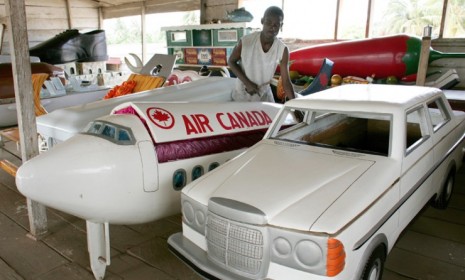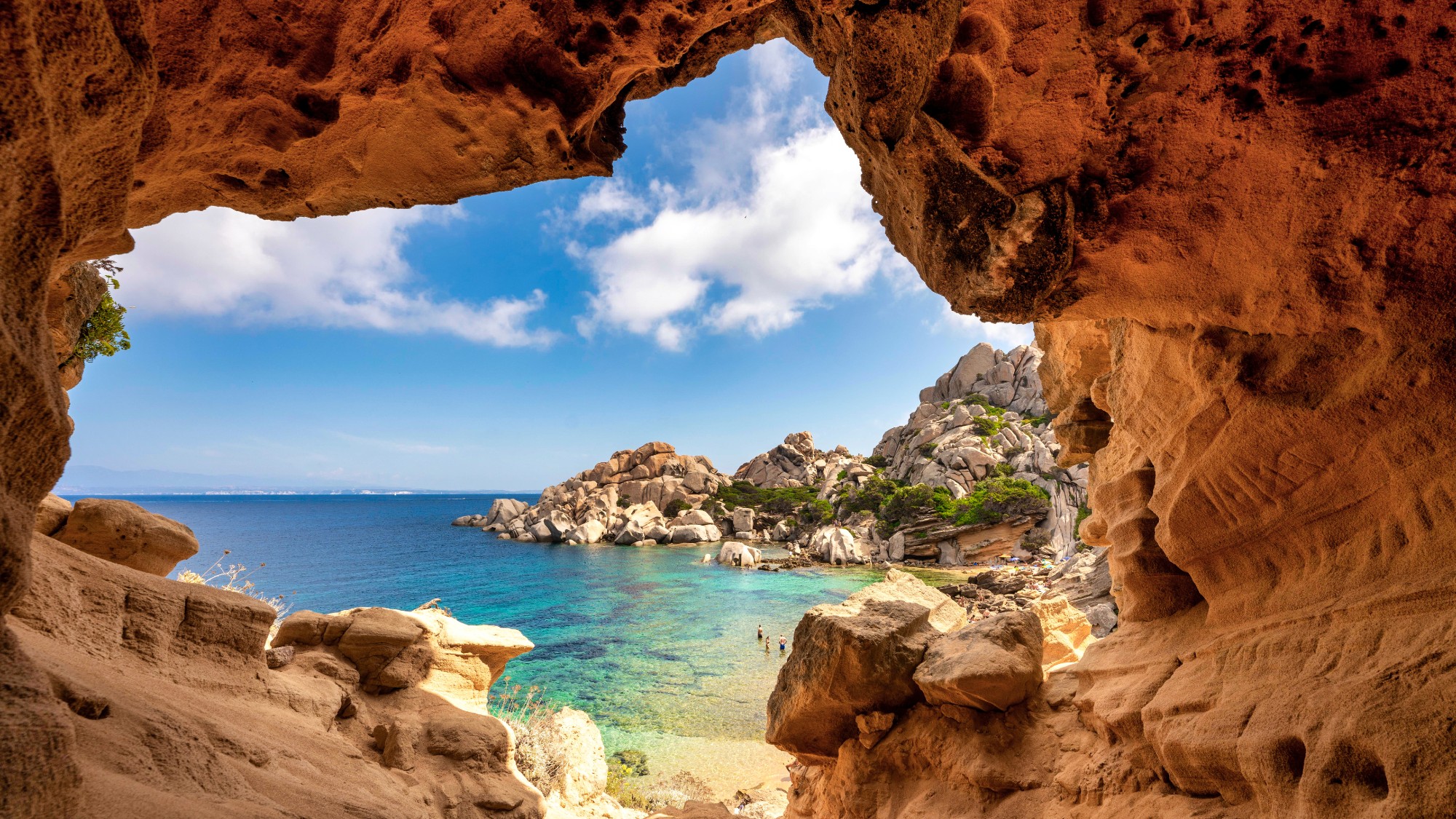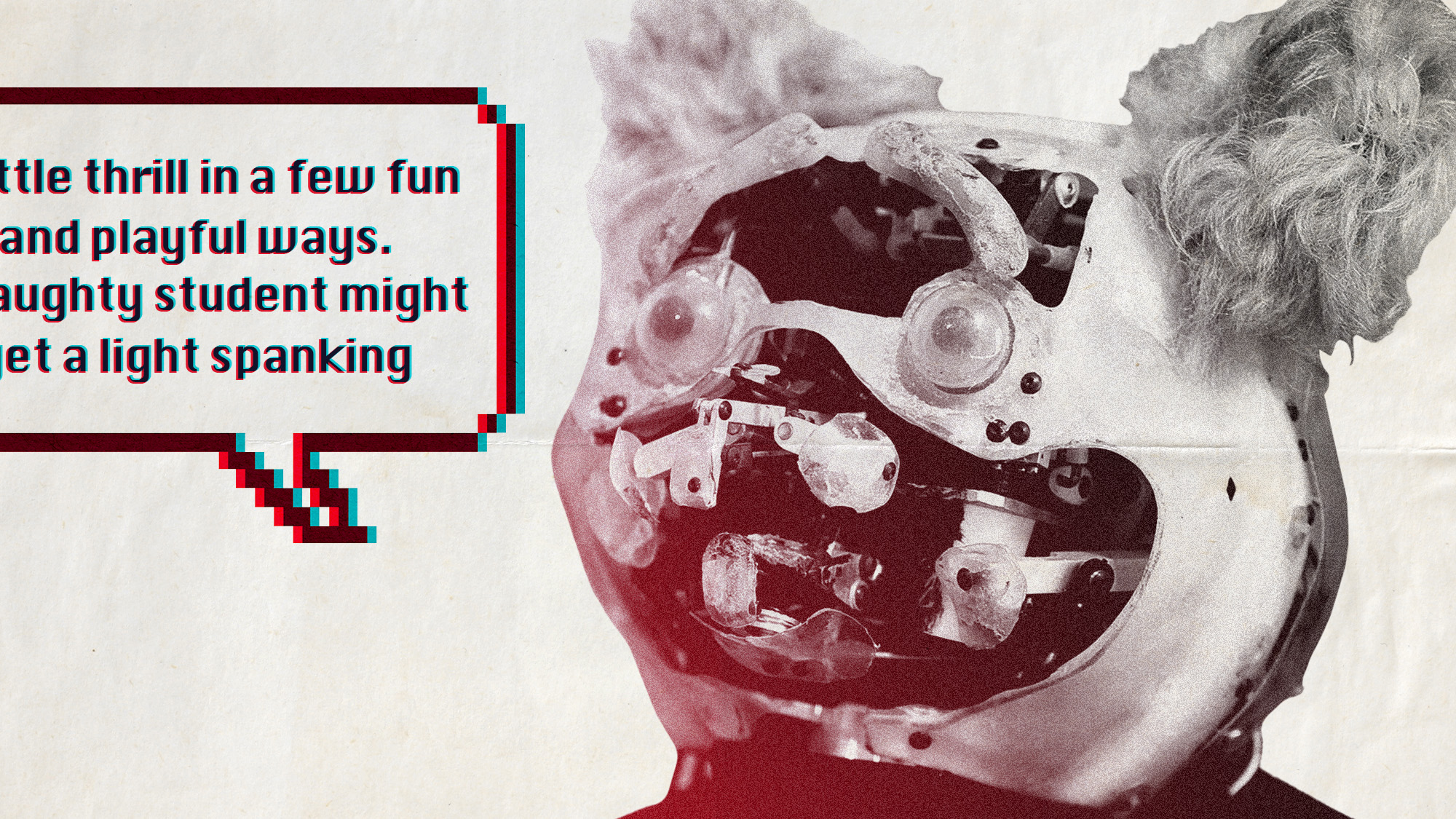Buying a personalized coffin in Africa
In Ghana, coffins are designed to look like Coke bottles, fish, and cars. One woman's story of ordering one of her own

AS SOON AS we shake hands, I know I'm going to like Eric Kpakpo Adotey. He's got sparkly eyes and the sweetest smile. He's sturdily built, and has a look of youthful vitality, something I feel is a good thing to find in a person — particularly when that person is going to be your coffin-maker. Eric and I meet at his workshop in Teshi, a seaside suburb of Accra, the sprawling capital of Ghana. Here, strung along a coastal road like beads on a necklace, are ramshackle shops and shacks housing the offices and workshops of traders, car mechanics, fishermen — and coffin-makers.
Commercial enterprises share the roadside with stalls whose neat pyramids of oranges are shaded by tattered beach umbrellas. There's plenty of time to take it all in. Traffic in Accra makes for a stressful visit, even when you're not on a mission to commission your own coffin. Still, two things about Ghana have, on previous visits, left me wanting to return. First, I always come away convinced that Ghanaians are the nicest people in the world. Second, they have the craziest coffins.
Ghana's tradition of fantasy coffins started by accident in the 1950s, when a chief from the Ga tribe who had made his fortune in cocoa farming commissioned a well-known carpenter to build him a giant cocoa pod as a ceremonial palanquin. The chief died before his palanquin was finished, so it was transformed into a casket and used for his burial. Today, Ghanaians who can afford it are buried in anything from an enormous Coca-Cola bottle to a massive fish. Monstrous chickens and scaled-down elephants are popular models, as are luxury cars. Majestic eagle caskets are generally reserved for chiefs, and huge vegetables for farmers. Boldly carved in wood and painted in bright colors, they're more than coffins — they are works of art.
The Week
Escape your echo chamber. Get the facts behind the news, plus analysis from multiple perspectives.

Sign up for The Week's Free Newsletters
From our morning news briefing to a weekly Good News Newsletter, get the best of The Week delivered directly to your inbox.
From our morning news briefing to a weekly Good News Newsletter, get the best of The Week delivered directly to your inbox.
OVER THE YEARS, human bodies have been buried in all kinds of things — baskets, jars, earthenware pots, animal skins, dugout tree trunks, and even whole suits of armor. And coffins were not always used for burial. In 17th-century England, many parishes had a single coffin that was loaned out to parishioners to contain the shrouded body during the funeral service. Moreover, for many centuries, the graves of ordinary people were merely temporary homes; eventually their bones would be dug up and placed into crypts, charnel houses, and ossuaries.
Early American caskets, like their British counterparts, tended to be plain, often made of pine, although hardwoods such as chestnut or walnut were the choice of more affluent customers. Anthropoid shaped — wide at the shoulders and narrow at the feet — they were known as "toe pinchers." Today, caskets are churned out in impressive volumes. Batesville Casket Co. in Indiana, the world's biggest coffin-maker, produces them at an industrial rate; its executives compare what it does to car manufacturing. It buys the paint from the same suppliers and has even found that trends in car colors are later reflected in casket choices. However, the form of the casket — an anthropoid shape or an elongated rectangle — has remained much the same until recently. Rising obesity has prompted the arrival of new supersize coffins. In Indiana, one company has made a business "serving the oversize needs of the funeral industry." With coffins named Harvest, Heartland, and Homestead, the Goliath Casket company offers a variety of sizes — ranging in width from 29 inches to a massive 52 inches (the standard is 24 inches).
IT'S NOT OFTEN that you look at a picture of a casket and say, "I want one of those!" But this was my reaction to the Ghanaian fantasy coffins. I was captivated by their brilliant colors and crazy designs. And it seemed to me that knowing you'd be leaving the world in a giant orange fish or a huge wooden banana could make it slightly less traumatic.
Several months later, I'm sitting on a paint-spattered bench next to Eric, discussing my order. His voice has a delightful timbre — a gentle pitter-patter that turns into a chortle whenever humor enters the conversation. In Eric's showroom, there's a scaled-down model of a Ghana International Airlines plane with detachable wings, a scaled-up model of a Nokia cell phone, a couple of giant bottles of Star (Ghana's favorite beer), a huge white chicken, and a gigantic red tropical fish. They've all been decorated in brilliant colors — and they will all one day contain dead people.
A free daily email with the biggest news stories of the day – and the best features from TheWeek.com
I ask Eric where he gets his inspiration. "First, I listen to the people," he says. "After I hear them talking, I start to know them. Then I get my ideas. And usually, they know what they want."
Often, that's something relating to their lives — a favorite car, perhaps (Eric's current project is a Mercedes C360) — or a symbol of their profession. I'm not sure if the beer bottles are made for brewers or drinkers, but the fish are for fishermen, the keys for locksmiths, kiosks for storekeepers, and planes for pilots.
Building these coffins requires years of training. The craftsmen work from memory or from photographs of the objects, drawing the shapes onto planks of wood. They cut the pieces, glue them together, and, before painting them, sand them down to produce a silky-smooth finish. They make sure they get every detail right, from the logo on the label of a beer bottle to the registration plate of a Mercedes.
The variety of things they can produce is remarkable, but the coffins all have one thing in common — a sort of mad, comic, pop-art look that seems at odds with something as somber as death. Eric tells me that the tradition has changed the way people in Ghana feel about death and funerals. "Before, when we saw a coffin we were scared or we felt unhappy," he says. "Now people are not afraid, because these coffins are something they know — it's part of them, part of their life."
BEFORE I LEFT for Ghana, I'd spent quite a while thinking about what part of my life I wanted reflected in my coffin. As a writer who spends so much time in front of a laptop, a computer mouse seemed the most obvious — but there was something too depressing about the idea of leaving this world in a piece of IT equipment. A pen seemed a little anachronistic and unexciting, given Eric's evident powers of creativity. No, I needed something that reflected my life in another way, and finally I chose the Empire State Building, my favorite piece of architecture in New York.
On arriving at Eric's workshop, I show him a souvenir model of the building. He's never seen it before, nor has he heard of it, so I also give him a postcard to show him what it looks like as it soars skyward through the forest of skyscrapers that is my Manhattan home. I worried that it might be too difficult to replicate. Its surface is extremely detailed, with hundreds of windows, vertical art deco lines, and a delicate spire. But as I sit here admiring a giant crab to my left and a jumbo jet in front of me, I realize my commission will be easy. "Yes, I can do this," Eric says confidently. I believe him.
Then he gets out the tape measure. This is the moment I've been dreading. I can feel my heart racing, and the smile on my face is quickly turning to a rictus. In an attempt to distract myself, I gaze out at the waves crashing onto the beach beyond the coastal road next to his workshop, but it doesn't help — being measured for one's own coffin is, let's face it, extremely unsettling. Eric does the job cheerfully and efficiently, like a tailor measuring someone for a suit. But unlike a new suit, it's not something I'll necessarily look all that good in.
SIX MONTHS LATER, my coffin has arrived. With the packing case removed and the smell of fresh paint lingering about it, my Ghanaian Empire State Building is now standing in my apartment. It looks nothing short of fantastic.
But now the moment has come — the moment when I have to try it for size. Closing myself in gives me another moment of dread. It's not unlike the prospect of being buried alive, which has long been a source of terror to most people. In its most extreme form, it's known as taphephobia (from the Greek taphos or "grave"), and several famous people have suffered from it. Frédéric Chopin's dying wish, for his heart to be removed before his burial, stemmed from this fear. On his deathbed, in 1799, George Washington insisted that he should not be buried for three days after he died, just to make sure he'd really gone.
Edgar Allan Poe captured these fears in "The Premature Burial," a horror story in which an unnamed narrator describes his terror of being buried alive in his coffin. Poe's narrator provides horrifying details of the moment he wakes up in a confined space. He tries to scream but can only gasp, his chest "oppressed as if by the weight of some incumbent mountain." Attempting to move, his arms strike "a solid wooden substance, which extended above my person at an elevation of not more than 6 inches from my face. I could no longer doubt that I reposed within a coffin at last."
Poe's narrator, as we discover, turns out simply to have been unconscious in a boat. But such stories no doubt contributed to the Victorian practice of burying people with a bell hanging on the tombstone above. The bell was linked to the buried coffin by a rope or chain, which could be pulled so that, in the event of an overly hasty burial, the occupant could be saved by the bell.
With such thoughts in mind, I've decided to get into my coffin only in the presence of a friend who has kindly offered to indulge me before we head out for dinner. I'm glad she's standing there as I shut myself in. It's a tight fit. Eric certainly got his measurements just right — the top of the main section, just below the spire, is almost brushing my head. Strangely enough, being inside is not as bad as I'd expected, although I'm quite pleased to get out.
As the days and weeks go by, I get quite used to my Ghanaian coffin. It's part of the furniture now. Full of curiosity, friends have all been trooping around to have a look. I even get to pass on news of its arrival to Tony Malkin, an executive with the Empire State Building Co. By chance, I was commissioned to write a feature about the building's energy-efficiency program, part of a plan to make it a green building. Near the end of a phone interview with Tony, I can't resist telling him that my own version of the building is sitting in my apartment. After we hang up, I e-mail him a picture. A few minutes later, I get the reply. "I hope you correctly licensed the use of our image!" he deadpans. "If not, we will hunt you down to your grave!"
From Making an Exit, by Sarah Murray. ©2011 by the author and reprinted by permission of St. Martin's Press, LLC.
-
 8 incredible destinations to visit in 2026
8 incredible destinations to visit in 2026The Week Recommends Now is the time to explore Botswana, Mongolia and Sardinia
-
 Wave of cancellations prompt Kennedy Center turmoil
Wave of cancellations prompt Kennedy Center turmoilIN THE SPOTLIGHT Accusations and allegations fly as artists begin backing off their regularly scheduled appearances
-
 The dark side of how kids are using AI
The dark side of how kids are using AIUnder the Radar Chatbots have become places where children ‘talk about violence, explore romantic or sexual roleplay, and seek advice when no adult is watching’